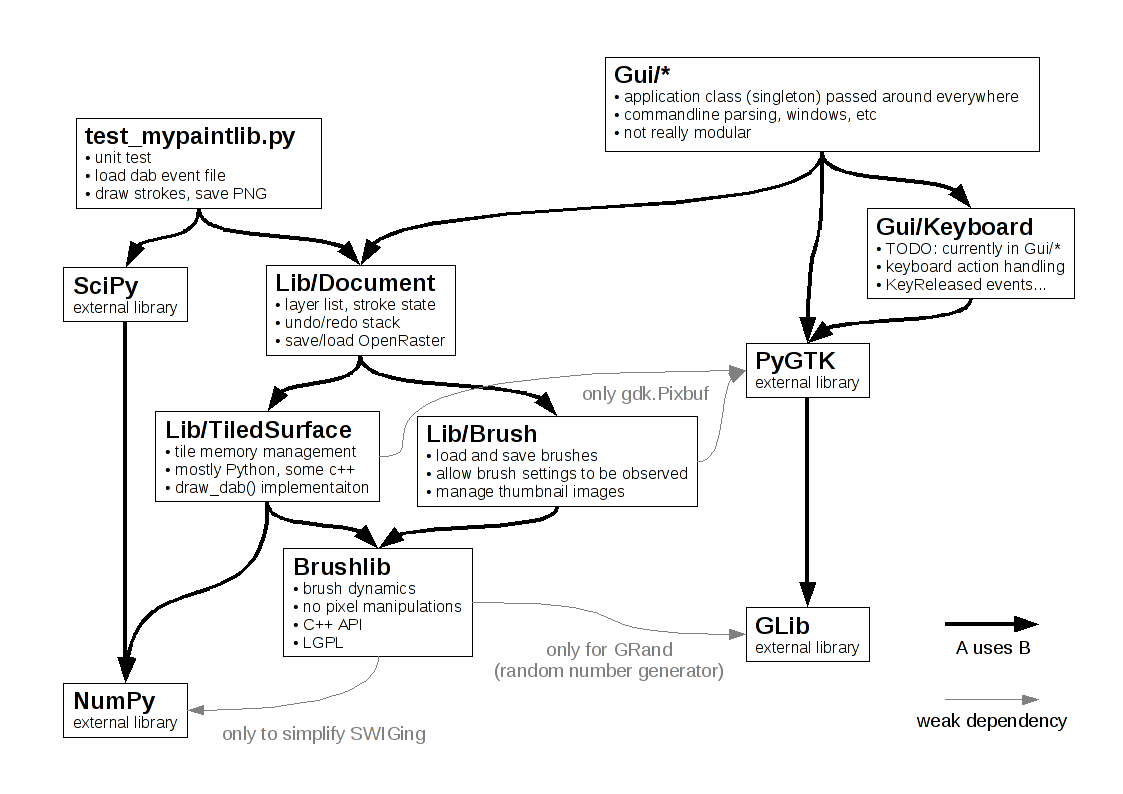Backend Documentation
This section concisely describes fundamental aspects of the project’s technology, including files and technical concepts to help developers conceptualise MyPaint. The most detailed documentation for the project will always be contained within the source code.
Warning
This section is heavily in development
Contributor Responsibilities
- Please write code that matches what you see elsewhere. Style guide
- Git workflow
- Contributed code must abide by our Licensing Policy
- Keep these docs up to date
- Documenting your code properly
Technology Overview
Here is a simplified (and somewhat outdated, sorry!) module dependency overview (some “weak” dependencies are not shown):
requirementDiagram
requirement test_req {
id: 1
text: the test text.
risk: high
verifymethod: test
}
element test_entity {
type: simulation
}
test_entity - satisfies -> test_req

Tooling
MyPaint (the painting application) is written in Python. MyPaint uses GTK for its user interface, some of the more complicated bits are designed in Glade. Some parts are coded in C++ for speed. Its brush engine is written as a portable C++ library.
- Building, Testing, & Packaging
- Setup.py uses distutils
- Tests use nose
- GitHub actions for CI
- GUI
- PyGObject (PyGI)
- Parts of the GUI are constructed in GLADE, other parts in the Python code
- Canvas
- NumPy
- Cairo
- Brush engine
- libmypaint
Windows
MyPaint uses MSYS2 for porting onto the Windows platform.
Pages in this Section
Unit Testing
We like to use doctest in Python code. There are a number of standalone test
scripts too.
GUI
MyPaint uses GObject-Introspection (“GI”) to access certain third-party libraries. This is a mechanism that allows library code written in a compiled language to be used by scripting languages. It’s normally not possible to do this directly. The Python library for using other libs through GI is called PyGObject or PyGI.
Data
How MyPaint handles data
Canvas
How MyPaint renders the canvas
Build Process
MyPaint’s build system is due to be replaced. Currently, the MyPaint application
is built with PyPa’s setuptools, with heavy utilisation
of distutils. The entry point to building MyPaint is setup.py,
configured by setup.cfg. This page details how MyPaint’s source
code is transformed into a working application.
Brush Engine
How MyPaint places content on the canvas
MyPaint is considering moving to a linear light workflow internally: this has significant artistic and aesthetic benefits for users. We’ll attempt to retain backwards compatibility for older images to reduce the impact of this change as much as possible.
Benefits of linear light
Linear light composition affects the way mid-range alpha pixels combine with the layers below them. You might see less fringing at the edges of brushstokes, and should see fewer artefacts around the edges of strokes when scaling. More difficult to spot are the effects when compositing one layer over another and altering the opacity of the top layer. changes to the opacity slider should result in brightness changes in a way that’s no longer proportional to the way the human eye responds: instead it’s proprtional to the way light combines.